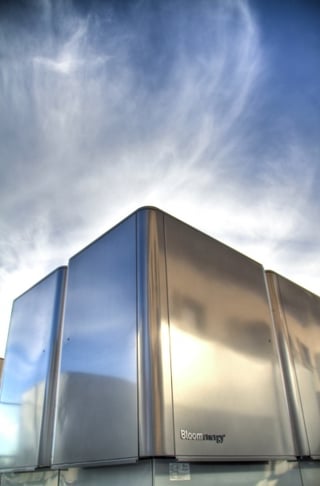
This post is one in a series featuring the complete slate of advanced energy technologies outlined in the report This Is Advanced Energy.
A fuel cell generates electricity via an electrochemical reaction, converting the chemical energy in fuel directly into electricity without combustion. Much like a battery, a fuel cell consists of three parts: an electrolyte, an anode, and a cathode. Unlike a battery, in a fuel cell hydrogen and oxygen react across the electrolyte to produce a continuous supply of electricity. Most fuel cells utilize natural gas or hydrogen as fuel, but landfill gas, and biogas from anaerobic digestion can also be used; for transportation or portable applications, methanol, ethanol, and even gasoline and diesel can be used. Fuel cell power plants are considered a form of distributed generation because they are small compared to traditional central generating stations, ranging from a few kilowatts for residential applications to tens of MW for larger industrial or grid-sited applications. With net electrical efficiencies of 60% or higher, fuel cells are more efficient than comparably sized onsite diesel or natural gas internal combustion engines.
Fuel cells are currently used to provide reliable, efficient onsite power (and thermal energy if used with combined heat and power) for many different industries, including computing and software, media, construction, food and beverage processing, grocery stores, hotels, warehouses, and distribution centers. They can also be placed on a utility’s distribution system to provide power and ancillary services to the grid. Walmart has installed over 12 MW of Bloom Energy fuel cell systems across more than 40 retail stores and distribution centers around the country, while Delmarva Power has installed fuel cell systems totaling 30 MW to meet the needs of utility customers in Delaware. The technology is mature but still at an early stage of commercialization, with high growth potential; Navigant Research projects that the global market for stationary fuel cells will increase from $1.4 billion in 2013 to $40 billion in 2022. U.S. fuel cell capacity totaled nearly 250 MW in late 2015, with California, Connecticut, and New York leading in total installations.
Because they are quiet and produce almost no emissions, fuel cells are well suited for onsite generation. In many states, fuel cell solutions are already cost competitive with power from the grid, with Bloom Energy fuel cells producing electricity at 8-10 cents per kWh. Costs are expected to fall as the market grows and manufacturing scales up. Fuel cells are an attractive option for onsite generation at facilities that place a high value on 100% reliable electricity. Microsoft is using anaerobic digestion to create fuel to power fuel cells at a data center in Wyoming; Apple is using fuel cells in combination with solar power to support its operations in North Carolina; and eBay, Inc. is using Bloom Energy fuel cells to power its data center in Utah. Fuel cells provide these companies not only with the reliability they need, but also choice of energy sources. In addition, fuel cells strategically sited on a utility network can provide grid support, delivering important services to improve reliability or defer costly grid upgrades. Delmarva Power in Delaware and Connecticut Power & Light and NRG Energy in Connecticut are all adding fuel cell capacity to deliver reliable power to their grid networks.
